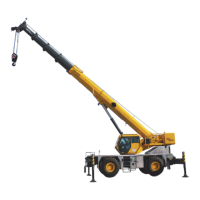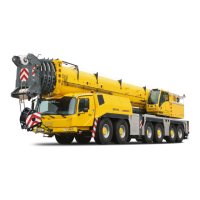2-57
GRT8100 SERVICE MANUAL HYDRAULIC SYSTEM
Published 3/26/2018, Control # 596-05
CARRIER COMBINATION MANIFOLD VALVE
Description
The carrier combination manifold valve (Figure 2-29 through
Figure 2-31) is located on the inside carrier frame rail at the
turntable bearing (Figure 2-17). Functions controlled by this
manifold valve include the following:
• LS Dump
• Rear Steer
• Axle Lockout
• Outriggers (Extend/Retract)
• Oil Cooler Fan
Supply oil to all functions on the carrier combination manifold
valve is limited by a pressure reducing valve set to 2750 psi.
Load Sense Dump
The LS dump function consists of a shuttle valve and a
control valve which combines the load sense oil received
from the carrier and superstructure circuits and diverts it to
tank during engine cranking. This action aids in starting the
engine by preventing the pumps from building pressure
during the engine cranking function, thereby lessening the
load on the engine starter.
Rear Steer
The rear steer function is controlled by a control valve with
dual cross-port, pilot-operated check valves in the work
lines. The dual cross-port, pilot-operated check valves
maintain pressure on the rod and piston of both rear steer
cylinders when stationary and when turning.
Axle Lockout
The axle oscillation lockout functions consists of a 100 psi
pressure regulating valve and two control valves. The circuit
prevents the axle lockout cylinders from oscillating unless
the turntable is centered forward.
For CE units, one of the two-way, two-position solenoid
valves is replaced with a three-way, two-position solenoid
valve. Additionally, four two-way, solenoid-controlled poppet
cartridge valves are installed in the ports of the lockout
cylinders.
An angle encoder located in the top of the electrical slip ring
assembly sends a CAN bus message to the RCL. The RCL
converts the data in the message to a position angle of the
superstructure relative to the carrier (slew angle). If the slew
angle is ±2° of directly over the front, the RCL sends a CAN
bus message to the control system to allow axle oscillation.
When the control system receives this message it switches
ON a digital output thus energizing the axle oscillation
solenoids. If the angle is more than 2° left or 2° right of
directly over the front, the control system switches OFF the
digital output thus de-energizing the axle oscillation
solenoids.
When the axle oscillation normally-closed solenoid valves
are de-energized, the lockout cylinders are isolated from
hydraulic oil supply. This keeps the cylinders from oscillating
(moving up and down to dampen axle movement) because
hydraulic oil cannot leave the cylinders. Instead, the
cylinders remain full of hydraulic oil and rigid.
When the axle oscillation solenoid valves are energized and
open, hydraulic oil is allowed in and out of the cylinders,
allowing them to oscillate.
Outriggers
The outrigger extend/retract circuit consists of a solenoid-
controlled valve, which is controlled by the control system
based on operator inputs. A request to extend or retract an
outrigger jack or extension results in the crane control
system energizing the respective solenoid, thereby sending
system pressure to shift a dual pilot-controlled valve, which
controls the flow of oil to extend and retract the four jack
cylinders and four extension cylinders. A check valve
maintains a maximum pressure of 100 psi in the retract
circuit.
Oil Cooler Fan
The oil cooler fan circuit consists of a proportional flow
control valve in sequence with a solenoid-operated,
proportional flow control valve, which is controlled by the
crane control system, based on inputs from the transmission
oil temperature sending unit and the hydraulic oil sending
unit. Return oil from the motor goes to tank.
Maintenance
Removal
1. Tag and disconnect the electrical connectors to the
valve. Tape the lead ends.
2. Tag and disconnect the hydraulic lines to the valve
assembly. Cap or plug the lines and ports.
3. Remove the capscrews, nuts, and washers securing the
valve assembly to the frame. Remove the valve as a
complete assembly.
Installation
1. Install the valve assembly to the frame. Secure the valve
assembly with the flatwashers, lockwashers, hex nuts
and capscrews. Torque capscrews - refer to Fasteners
and Torque Values, page 1-15 for proper torque value.
2. Connect the hydraulic lines to the valve assembly as
tagged during removal.
3. Connect the electrical connectors to the valve assembly
as tagged during removal.

